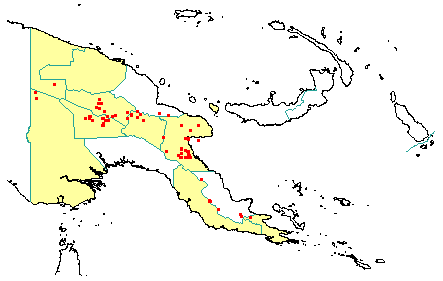
in PNGplants database
PNGTreesKey – Phyllocladus hypophyllus Hook.f. |
Barry Conn (NSW) & Kipiro Damas (LAE).
Guide to trees of Papua New Guinea
Copyright held by the authors, National Herbarium of New South Wales, and Papua New Guinea National Herbarium
Hooker's Icones Plantarum 889
Family: Podocarpaceae
Conifer
Timber Group: Softwood
Field Characters: Large canopy tree (25-35 m high); Bole cylindrical (to slightly fluted, 60-100 cm diam.); straight (bole mostly 10-20 m long); buttresses buttresses present (slightly base of trunk sometimes spurred up to 2.5 m) or buttresses absent; spines spines absent; aerial roots aerial roots absent; stilt roots stilt roots absent; Bark dark brown, rough, pustular, lenticels rounded/swelling; Subrhytidome (under-bark) dark red or brown; less than 25 mm thick, 10.0-20.0; bark blaze consisting of one layer; faintly to non-aromatic; outer blaze pink, markings absent, slightly fibrous or granular without splinters; inner blaze pink, markings absent, slightly fibrous or granular without splinters; bark exudate (sap) present, colourless, flowing, colour not changing on exposure to air, not sticky; terminal buds not enclosed by leaves.
Indumentum: Complex hairs absent; stinging hairs absent; mature twig indumentum (hairs) absent.
Leaves: Leaves spaced along branches (by misinterpretation (actually leaf-like branchlets, called phyllodes), spiral (leaves occurring singly at a node and arranged spirally up the branchlet), simple (a leaf composed of a single blade) (foliar shoots modified into flattened leaf-like cladodes which involve a central axis and several alternate side 'shoots'); petiole present (base of cladode narrowed to form a petiole-like structure), not winged, attached to base of leaf blade, not swollen; leaves broadest above middle, broadest at or near middle, or broadest below middle, (50.0-) 60.0-80.0 cm, 25.0-30.0 cm; symmetric (to slightly irregular), irregularly crenate or serrate to dentate (toothed), dissected or lobed or not dissected or lobed, irregularly pinnately lobed, obtuse or long-tapering (shortly), venation pinnate, secondary veins closed, not prominent, but visible, intramarginal veins absent; leaves lower surface green (glossy), upper surface green (glossy), indumentum (hairs) absent; absent; domatia absent; stipules absent.
Flowers: Inflorescence terminal (female cones inserted in an apical notch of a bilobed cladode or terminal on a reduced cladode) or axillary (male cones inserted in axil of a scale-leaf at base of a growing short-shoot), flowers arising from a single point, cones absent; flowers unisexual, unisexual with male and female flowers on the same plant or with male and female flowers on different plants, not stalked, flowers slightly asymmetric (female and male cones) or with one plane of symmetry (male cones), 6.0 (c.) mm long, diameter small (up to10 mm diam.) (c. 3 mm diam.); perianth absent; stamens 1, absent, free of each other; ovary superior, carpels solitary, locules 1; styles absent.
Fruits: Infrutescence arising from single point (small clusters on stalks or terminal on phylloclades - leaf-like structures), fruit 5.0-8.0 mm long, 5.0 (c.) mm diam., brown (dark (glossy), not spiny, non-fleshy, simple, indehiscent, naked seed only; seeds 1, to about 5 mm long (5-7 mm long), not winged, broad (as wide as long), seed 1-10 mm diam. (5-6 mm diam.).
Distribution: West Sepik, East Sepik, Morobe, Western Highlands, Eastern Highlands, Southern Highlands, Western, Central & Milne Bay.
 | Botanical records in PNGplants database |